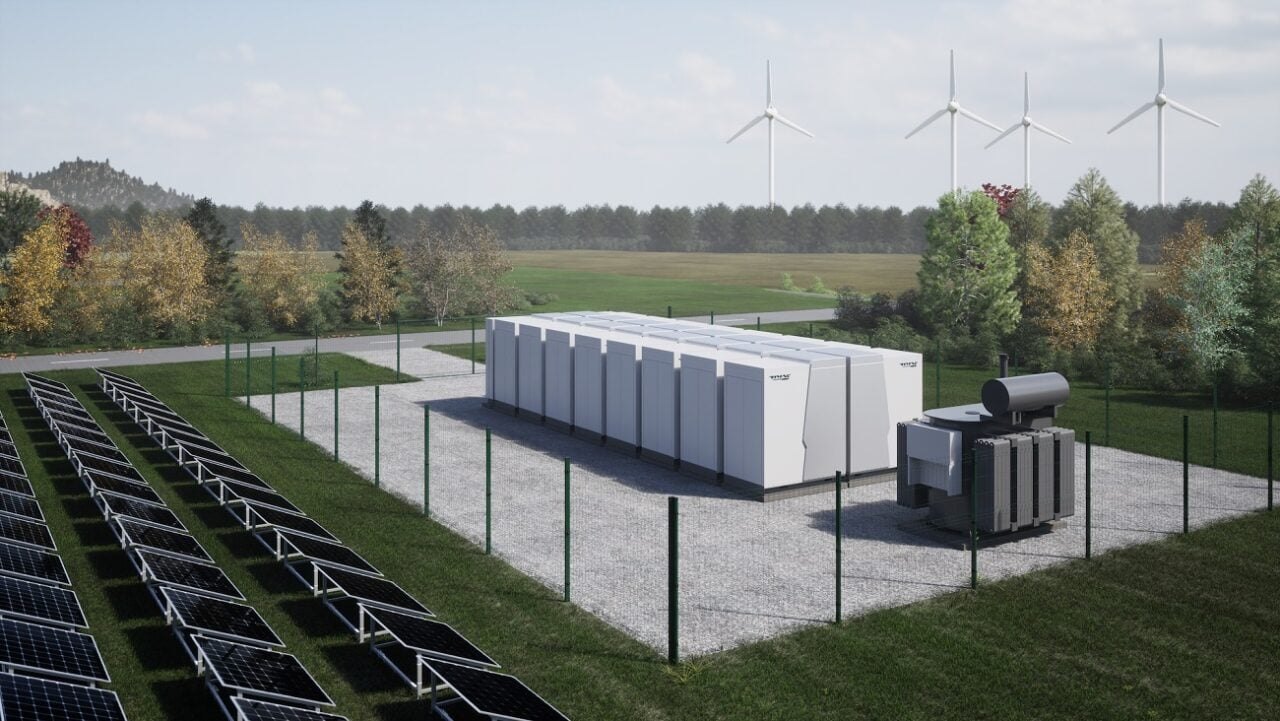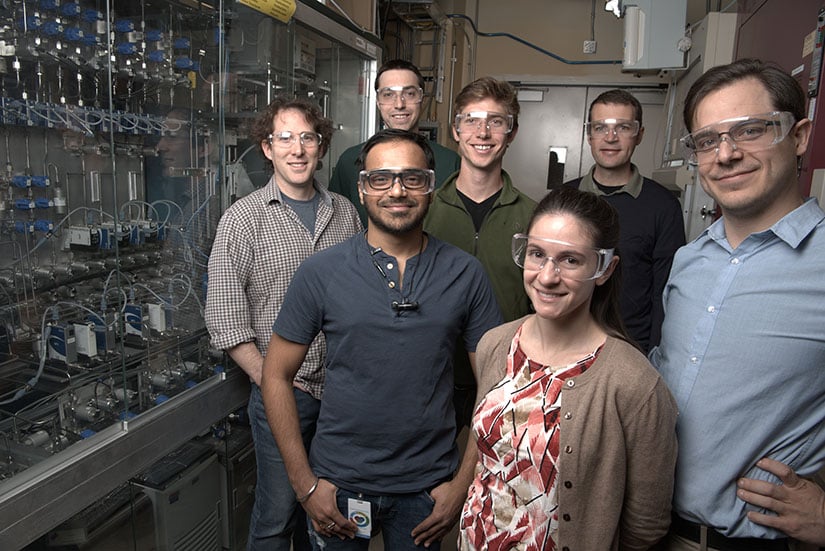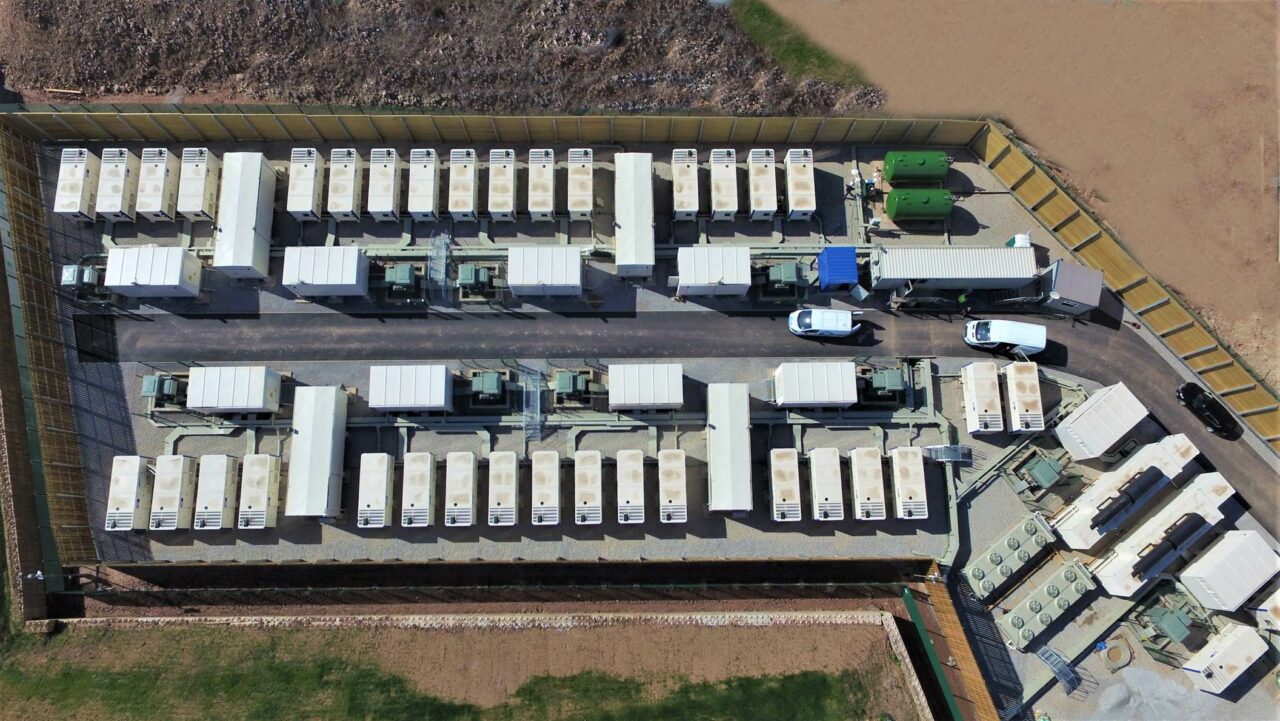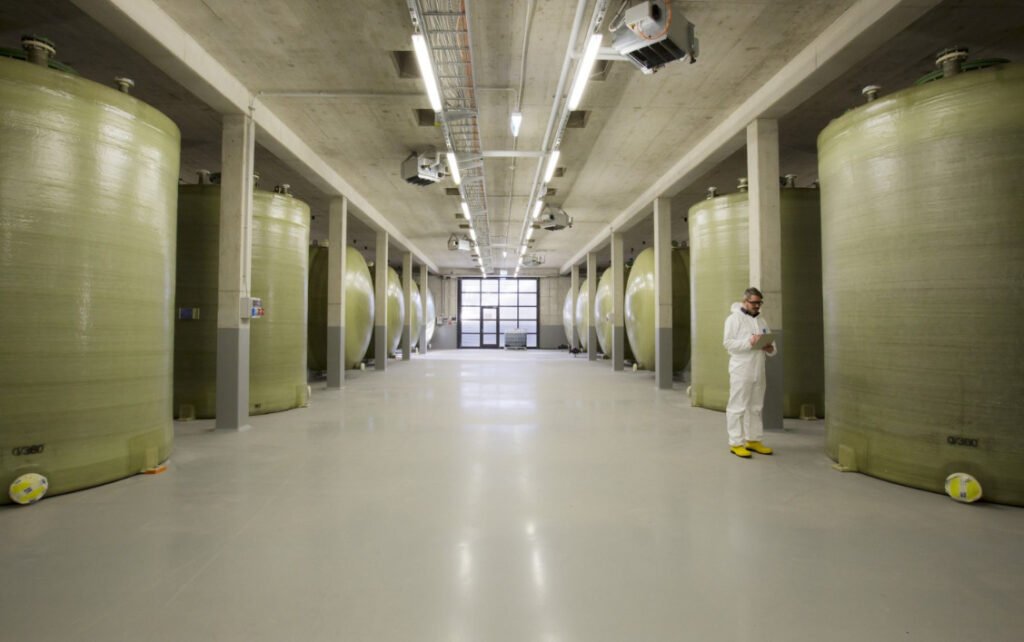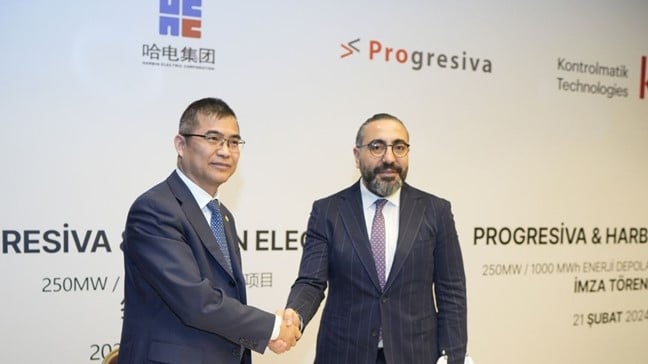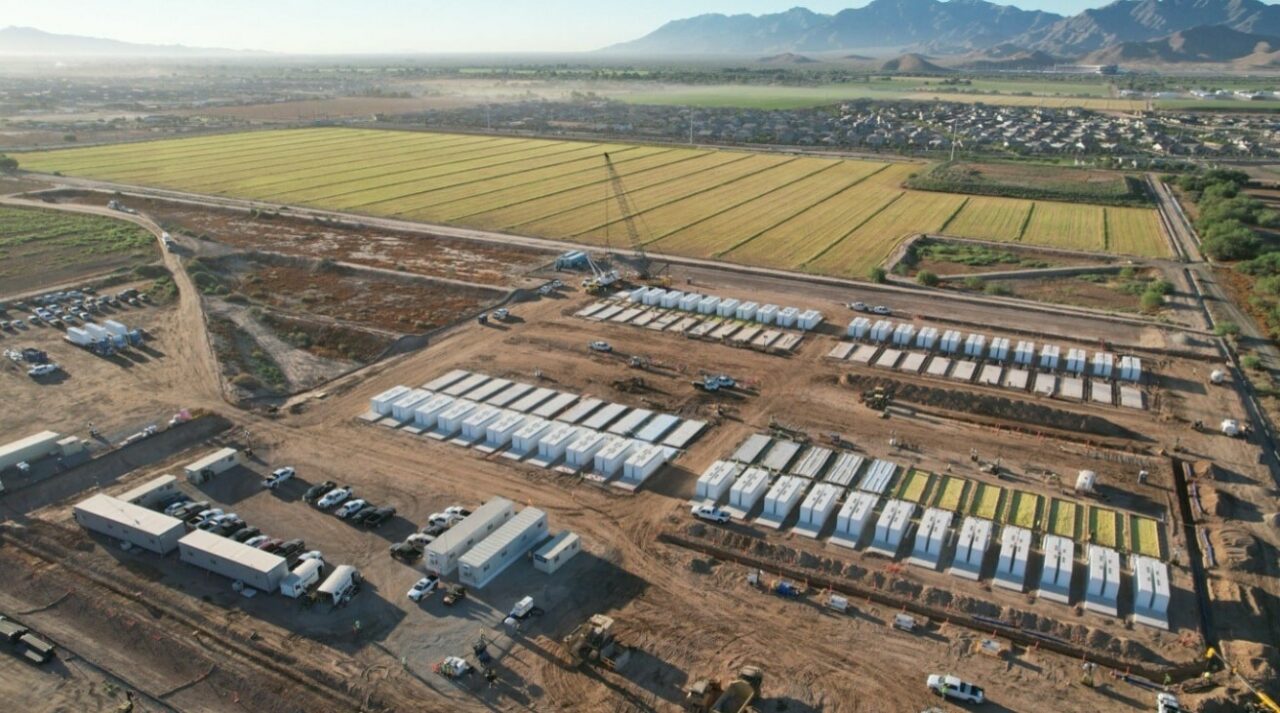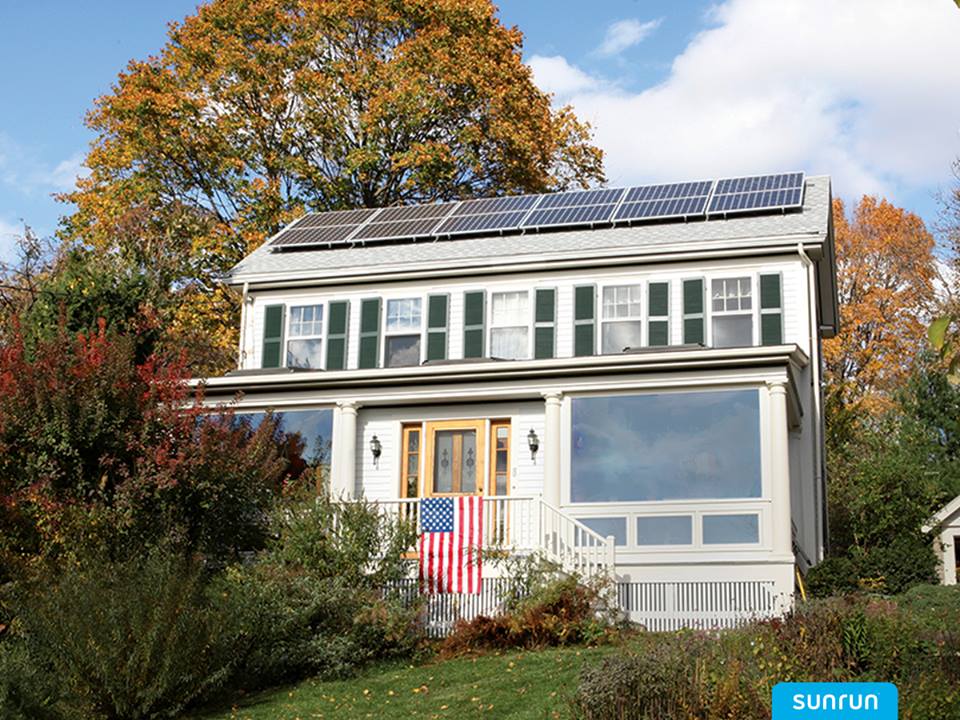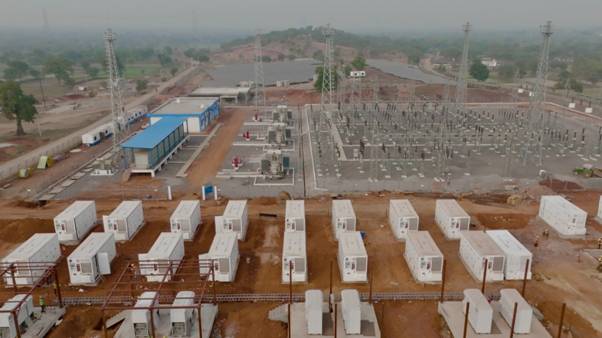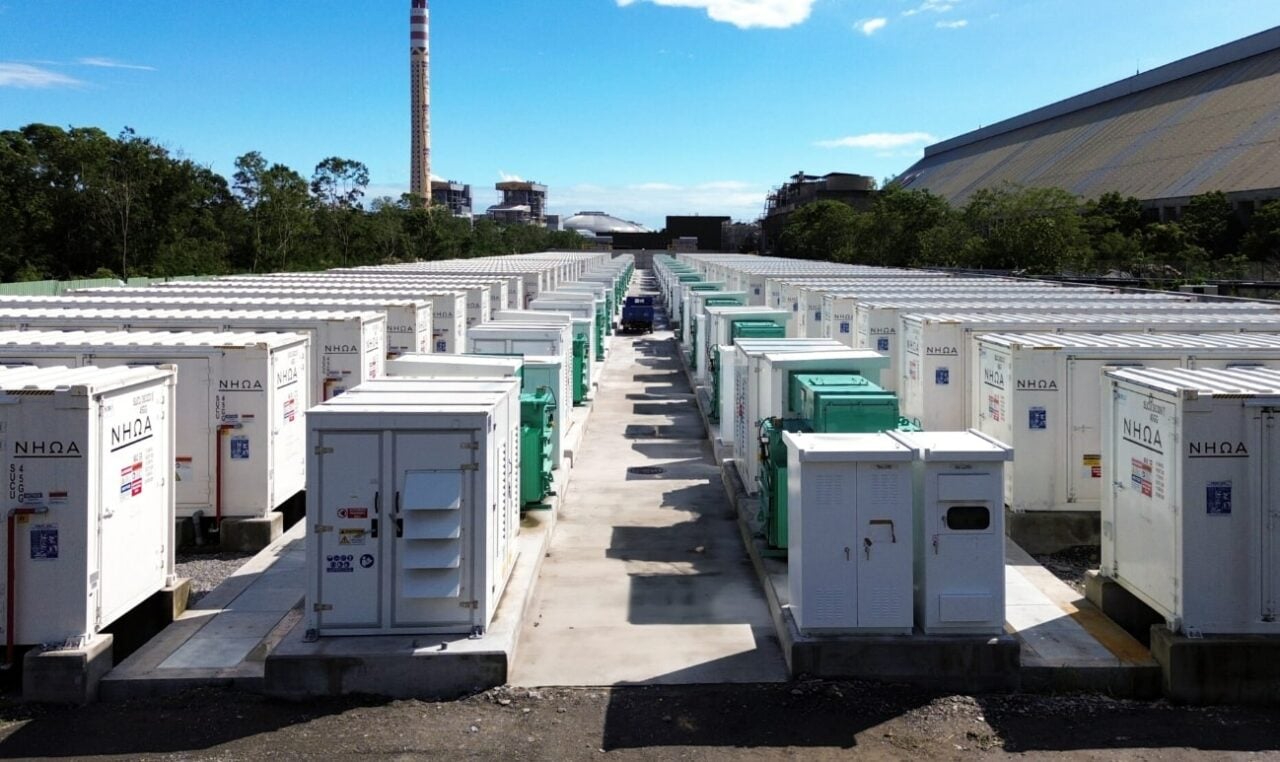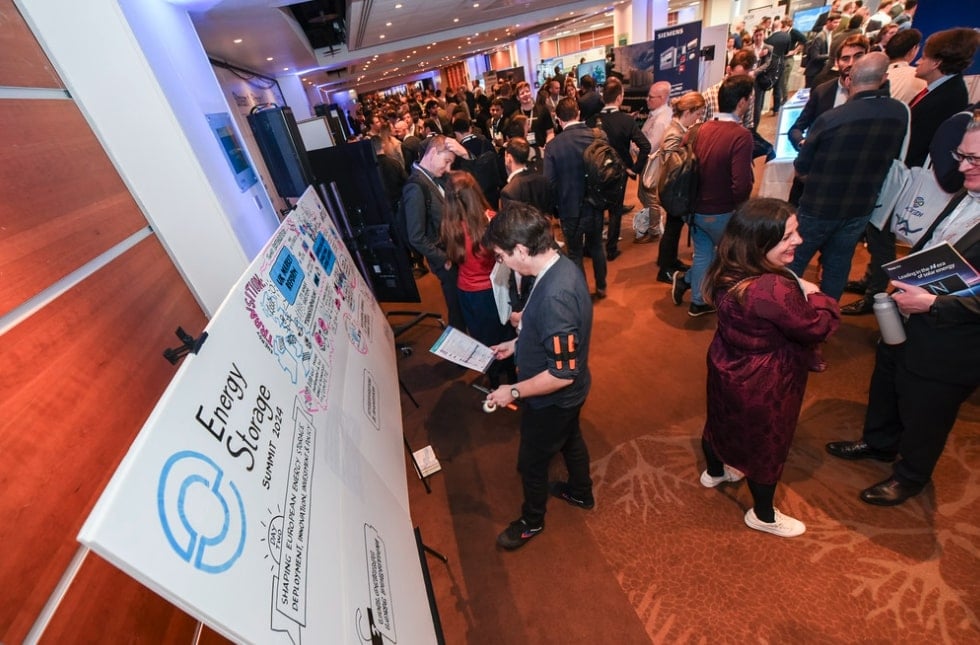Rimac Energy is the stationary energy storage arm of Rimac Automobili, the Croatia-headquartered high-performance electric vehicle (EV) technology company which also owns a majority interest in legacy supercar brand Bugatti.
Rimac Energy announced its plans to enter the ESS market in Spring 2023 and first presented its SineStack battery energy storage system (BESS) product at our publisher Solar Media’s Energy Storage Summit Central Eastern Europe (CEE) in September 2023, officially launching it a month later.
Rimac Energy positions itself as ‘European’ player
“We are establishing ourselves as the leading European player, with a European product, European software, European manufacturing and a majority European supply chain,” Laublaettner says.
The firm’s first two projects for Croatian renewable energy developer and operator ENNA will be built at Rimac’s UK location while a larger manufacturing facility is being developed at its Croatia hub.
The first two projects will together total a ‘single-digit’ MWh figure and will go online in the second half of 2024. Laublaettner: “We’ll use these projects to prove the technology and build a track record. We’ve finished with the technological iterations to the Sinestack for the product we are launching.”
The Sinestack’s key differentiating feature it its distributed inverter topology architecture where the inverter capability is distributed amongst all of the modules giving independent control over every 18 cells in each 790kWh unit.
“We’re establishing our manufacturing lines currently, which will soon be multi-GWh and we intend to be one of Europe’s biggest manufacturers of ESS by 2030 with a significant double-digit GWh production figure.”
The company is targeting the supplying to the grid-scale, commercial and industrial (C&I) and battery-integrated EV charging market segments.
Laublaettne adds that it is hard to say who is the largest BESS manufacturer in Europe today as the capacity figures are generally quite hidden.
The projects with ENNA are in Germany and Croatia and are part of a 1GWh framework agreement between the two companies.
Staying competitive in a market with falling prices
We then ask Laublaettner what Rimac’s approach to pricing will be. Its parent company’s Nevera supercar retails for around €2 million (US$2.2 million), 30-40x the average price of a new electric vehicle (EV). Laublaettner is clear that the ESS market requires a vastly different approach.
“We don’t position ourselves as the Bugatti or the Rimac on the stationary side, we know competitive pricing is absolutely key. The performance will be the Rimac of the market, but not the pricing,” he says.
“The key thing is to have a strong supply chain and to have contracts in place that will adjust with pricing adjustments. Having the scale and ability to control the product vertically leaves us in a space where we can offer highly competitive pricing.”
Average prices in the global BESS market have fallen dramatically since the highs of 2022, with Clean Energy Associates (CEA) and system integrator NHOA Energy both saying they fell around 20% in 2023, while CEA estimates another 20% fall in 2024 (for US customers). One driver of this is the fall in lithium carbonate prices but increasing competition from Chinese companies on the global stage is also a major factor.
Battery cell procurement: China and Europe both options
A big part of the question around pricing is from where and whom Rimac procures its battery cells, which it is not building itself. The company has claimed its background in high-performance EVs means it is well-suited to extracting maximum performance from a given set of cells.
While it is presenting itself as a European company with a European supply chain, China is still the only place to go to procure lithium-ion battery cells at scale, although Europe is trying to develop its own lithium-ion battery ecosystem. Laublaettner says Rimac will offer systems with both Europe and China-made cells depending on the needs of the customer.
“At the moment, if someone wants competitive pricing the cell will come from China. We have ensured all potential suppliers of our cells will have the option for full European sourcing by 2027, and we also do see new European manufacturers but then it’s the question of the customer preferences: are they willing to pay more to have a European cell or just go for the cheaper one? That is a discussion that will continue until there is a high volume of production in Europe.”
Laublaettner also discusses how flexible the company’s SineStack solution is in terms of using different cells. Optionality is seen as key by many of the key incumbent system integrators in the market.
Laublaettner: “In general, our technology is cell-agnostic as long as the format is the same, we can use cells from different suppliers. The key thing is we look at multi-sourcing but of the same format – we’ve been working closely with leading cell suppliers and think we’ve got some really impressive cells both technically and comercially. Our solutions are all LFP right now, but we also have compatibility with Na-Ion (sodium-ion).
“The unique electrical architecture of our system, sophisticated state detection (such as state of charge estimation), and our battery optimisation software helps us extract more energy and more lifetime out of a given set of cells.”
Thermal energy storage startup Antora raises US$150 million for industrial decarbonisation
Antora claims that not only can TPV cells be mass-produced, but that their efficiency for converting heat into electricity exceeds 40%. Meanwhile, the cells are lightweight, solid-state devices with no moving parts, and their modular design means efficiency and cost are independent of scale.
The heat component can reach temperatures in excess of 1800°C, which can meet the requirements of sectors such as cement and steel production, often named among the ‘hard-to-abate’ industries for emissions.
Industrial activities account for around 30% of global emissions, making them the single biggest contributor, with about half of that represented by industrial heat.
According to a report from the global trade association Long Duration Energy Storage Council (LDES Council) published late last year, the application of renewable energy-generated heat and electricity storage to the industrial sector could reduce industrial emissions by roughly two-thirds. A report commissioned by the LDES Council a year before in 2022 focused on the potential of thermal energy storage to effectively provide several hours of storage capacity, which it described as being crucial for global decarbonisation.
Antora joins a growing roster of global thermal energy storage companies seeking to deploy their solutions into the sector, most of which claim their technologies can deliver energy and power at costs competitive with lithium-ion, while providing heat in particular more effectively than electrochemical batteries.
Big name investors join Breakthrough, Grok
The Series B round, combined with a 2022 Series A, brings the startup’s total attracted investment to more than US$230 million. The company first featured in Energy-Storage.news during that round, with Bill Gates-founded sustainability-focused venture capital group Breakthrough Energy Ventures among investors. It also received some early-stage support from the US government and the state of California.
The latest Series B was led by Decarbonization Partners, formed by BlackRock and Singapore-headquartered asset manager Temasek. BlackRock has to date invested in a number of downstream battery storage project developers, while Temasek’s involvements in the space have included investment in US ‘multi-day’ battery startup Form Energy, and lithium iron phosphate (LFP) manufacturer Our Next Energy (ONE), also based in the US.
Also taking part in the round were new investors, including a subsidiary of NextEra Energy Resources and the Nature Conservancy, along with existing investors including Breakthrough Energy, BHP Ventures and Grok Ventures.
The investment will allow Antora Energy to scale up its manufacturing and commercial deployments, with the company having begun producing a commercially available thermal battery product as well as announcing the development of a California factory to produce them at scale.
Initial units are expected to roll off the production line at the 50,000-square-foot factory later this year. Antora CEO and co-founder Andrew Ponec claimed the Series B’s closing represented an investment in “US jobs, manufacturing, and leadership in the clean energy transition,” as well as in the company itself.
Energy-Storage.news’ publisher Solar Media will host the 6th Energy Storage Summit USA, 19-20 March 2024 in Austin, Texas. Featuring a packed programme of panels, presentations and fireside chats from industry leaders focusing on accelerating the market for energy storage across the country. For more information, go to the website.
‘Battery developers were biggest winners’ in UK’s T-1 Capacity Market auction last week
As reported last week in some detail by our UK-based sister site Current, this was 40% lower than prices at clearing in the previous year’s auction.
Battery energy storage system (BESS) assets got 8.58% of that total, with 655.16MW of bids successful, and pumped hydro energy storage (PHES) assets 2.43%, or 185.38MW.
While that was therefore dwarfed by the 38.53% of capacity won by gas-fired generation (around 3GW) and 2.76GW won by nuclear (36.22%), battery storage was the leader among renewables and non-thermal generation technologies.
“The biggest winners in this week’s auction were the large number of battery developers who will be able to supply power to the UK next year when the system is short,” Sam Hollister, head of energy economics and finance at energy transition research and consultancy group LCP Delta said after publication of results.
Coupled with this week’s T-4 auction, which will secure capacity four years out from delivery year, the overall cost of the two Capacity Market solicitations could be around £3 billion of taxpayers’ money, Hollister said.
With the T-1 costing about £273 million in contracts, the T-4 could cost about £2.6 billion, the economist said, with 44GW of generation targeted.
The T-4 auction is expected to clear today and the industry’s expectation is that prices will be much higher than at T-1. Hollister said T-4 prices could exceed last year’s £63/kW/yr, which was a record-breaking level at the time.
According to the LCP Delta analyst, EDF’s nuclear fleet was also a winner, getting lifetime extensions into 2025.
“These winners were boosted by an underestimate of demand as well as some planned assets coming on line date either being delayed or cancelled entirely,” Hollister said.
“For [the] T-4 auction, we will have to wait and see the outcome, but we anticipate an increasingly tight scenario as power stations retire and electricity demand increases.”
T-1 Capacity Market prices ‘slightly above expectations’
Battery storage developers Harmony Energy Income Trust and Gresham House Energy Storage Fund, both commented after results came out that prices for T-1 had been slightly above expectations. As noted by Current, it was 40% below 2023’s equivalent, which cleared at £60/kW.
Gresham House Energy Storage Fund said it secured 1-year contracts across 13 of its fleet of lithium-ion BESS assets, with a total derated capacity of 90.491MW, noting in an update to shareholders that the contracts would be worth £3.2 million in additional revenue between October 2024 and September 2025.
The net asset value (NAV) benefit of the contracts will be recognised at the company’s next valuation date, 31 March 2024.
“We’re pleased with these results from the latest annual Capacity Market auction, as well as their expected positive contribution to our NAV from 31 March 2024,” Gresham House fund manager Ben Guest said.
Guest added that the flexibility of battery storage assets is “one of the great attributes” of the technology, with Gresham House able to “swiftly and remotely configure” its software to tap into a “wide range of potential revenues,” both contracted or merchant, without requiring any changes or updates on the hardware side of the systems.
Harmony Energy Income Trust also said the clearing prices were higher than the company had expected. Six of its assets made successful bids and would contribute around £1.7 million to its contracted revenues for the delivery period.
The fund said that two assets in its portfolio, Broadditch and Farnham, did not compete in the T-1 auction because they already have T-4 CM contracts in place, with delivery from October this year, over a 15-year term. Projects cannot hold two CM contracts over the same or overlapping delivery periods.
Gore Street Capital, the third of the UK’s listed funds dedicated to energy storage assets, got contracts for five assets.
As has been widely reported, the UK’s otherwise booming energy storage market has experienced a period of relatively low revenues over the past winter, impacting the share price of all three listed funds.
At last week’s Energy Storage Summit EU, held in London, UK, the audience heard that the CM revenues, while only comprising a minor portion of the BESS revenue stack for successful bidders, are an important way to get fixed revenues over contracted periods.
Head of capacity market policy at the UK government Department of Energy Security and Net Zero (DESNZ) Georgina Morris said that according to “various commentators,” CM revenues are becoming a more important part of the battery storage revenue stack.
The fact that the CM offers a guaranteed payment is thought to be especially welcome in today’s high interest-rate environment, Morris said. The DESNZ representative quoted figures from industry analysis group Modo Energy, which found that average UK BESS revenues of £51,000/MW/yr go up to around £61,000 with Capacity Market revenues factored in.
Elsewhere in Europe, Italy and France have both held capacity market auctions with battery storage assets eligible to take part, while Germany is thought to be considering a launch. As reported by Energy-Storage.news yesterday, in the US, more than 1,800MW of battery projects won contracts in the most recent ISO New England auction, a massive leap from just 5MW that cleared five years ago.
BayWa, Ampt and Fraunhofer complete ‘European-first’ wind-solar-flow battery hybrid project in Germany
A 690kWp solar PV array has been added to an existing 2MW wind turbine, which have been ‘DC-coupled’ meaning both sit behind the same inverter using Ampt’s string optimisers. The companies claimed this combination of solar PV, wind and storage is unique in Europe, and that the project would help Fraunhofer ICT’s campus towards climate-neutrality.
The 10MWh flow battery which completes the trio of technologies was also already operational although the announcement gave no additional details on it, be it technology provider or type of electrolyte used.
However, it appears to be the same flow battery that was deployed as part of Fraunhofer’s ‘RedoxWind’ demonstrator project, pictured further down.
According to a page on Fraunhofer’s website published in 2019, the RedoxWind project saw the deployment of a redox flow battery with a ‘final stage capacity’ of 2MW/20MWh connected directly to the DC circuit of a wind turbine at the Pfinztal campus. The aim of the project was to study the synergies and relationship between the wind plant and the energy storage system.
The RedoxWind project was publicly-funded with equal contribution from the State of Baden-Württemberg and the German Federal Ministry of Education and Research (BMBF). Energy-Storage.news has asked a spokesperson for BayWa r.e. to confirm it is the same project and will update this article if and when a response is received.
Flow batteries providers in the Germany, Austria and Switzerland (DACH) region include Austria-based vanadium redox flow battery (VRFB) company CellCube and Germany-based organic flow battery company CMBlu.
Ampt said its string optimisers use maximum power point tracking (MPPT) to recover energy losses due to voltage and technologies, as well as mitigate energy losses caused by share from surrounding buildings.
Andrea Grotzke, global director of energy solutions at BayWa r.e, commented: “The way we have added solar to the existing wind energy and battery storage system is unique, and in successfully completing this project we were able to further improve our own expertise and capabilities.”
The ‘RedoxWind’ redox flow battery at Fraunhofer ICT’s campus in Pfinztal, Germany. Image: Fraunhofer ICT.
Everdura to manufacture Invinity’s latest VRFB in Taiwan
In related news, VRFB company Invinity Energy Systems has announced that industrial group Everdura will start manufacturing Invinity’s latest product, Mistral, in Taiwan.
The pair have already been collaborating, with Everdura making a 15MWh order agreement in September 2022 which it then updated a year later to include Mistral, the latest generation of Invinity’s VRFB product.
Everdura is already Invinity’s reseller and will now manufacture Mistral VRFBs to fulfil orders, with 255MWh targeted over the next three years. Everdura will pay Invinity a royalty fee based on a material percentage of the sale price of Mistral products sold.
It will use Invinity’s existing supply chain and purchase cell stacks directly from the company, which will continue to be manufactured by Invinity at its production facilities in the UK and Canada.
Kontrolmatik and China’s Harbin Electric to deploy ‘first 1GWh wind-plus-storage’ project in Turkey
Harbin will finance the project which is being launched by another Kontrolmatik subsidiary, Progresiva, and is expected to come online in 2025. It will be built in Tekirdağ, near Istanbul, and was described as a “US$300 million” investment in the announcement.
It will be co-located with wind power project, the first gigawatt-scale project of its kind in Turkey, Kontrolmatik said.
On Kontrolmatik’s website, the company describes Progresiva as an investor in energy projects and an energy trader. It also claims Progresiva has the first and only standalone energy storage unit in Turkey and will commission a 250MW/1,000MWh facility in 2024 (it’s not clear if this is a separate project to the one agreed with Harbin Electric – both are in the northwest Marmara region).
A signing ceremony for the Harbin project, in the capital Ankara, was attended by the local ambassador for China, Liu Shaobin, and Turkey’s vice president Cevdet Yılmaz.
Turkey is emerging as a regional hub for lithium-ion gigafactory and energy storage system (ESS) manufacturing and is also expected to see a ramp-up in domestic energy storage installations too.
At the end of 2023, the government awarded pre-licenses to co-located energy storage projects totalling 25.6GW of power and also imposed a 30% tax on lithium iron phosphate (LFP) batteries imported which, Energy-Storage.news was told by a local industry source, would boost the local upstream market (Premium access).
Kontrolmatik has an LFP gigafactory in Ankara which began production in 2022, building on the company’s existing ESS assembly facilities. The gigafactory was launched through subsidiary Pomega, which is also building a battery cell and ESS production facility in South Carolina, set to be completed in July 2024 – Energy-Storage.news spoke to Pomega’s US VP business development Louis Caso about it in March last year (Premium access).
Over 1.8GW of energy storage clears in ISO New England’s latest Forward Capacity Auction
The ISO, which serves the six states of Connecticut, Rhode Island, Massachusetts, New Hampshire, Vermont and Maine said earlier this month (9 February) that contracts were awarded at US$3.58 per kilowatt-month (preliminary prices).
ISO New England also noted at that time that nearly all capacity supply obligations were awarded to wind, solar PV, energy storage or demand side reduction technologies. A total 31.5GW was awarded, selected from 36.8GW of qualified resources including 4,100MW new-build projects of various technologies.
Finalised results were filed with the Federal Energy Regulatory Commission (FERC) for approval, the ISO said last week (21 February).
Energy storage took a 6% share of that awarded total, amounting to more than 1,800MW of energy storage. While the majority will be existing facilities, more than 700MW of new build projects won with their bids.
The ISO said in a blog post that five years ago, only 5MW of energy storage cleared the auction, while the 15th auction, procuring resources for the 2024-2025 delivery years three years ago, saw 630MW of battery storage get contracts according to the Clean Energy States Alliance advocacy group and think tank.
While it is not readily apparent who all of the developers behind awarded projects are from the filing, two of the bigger new projects known to have won are Cranberry Point, a 150MW/300MWh BESS in development by Plus Power, along with Medway Grid, a 250MW/500MWh project by Eolian. Developer BlueWave also planned to bid in 200MW to the auction when interviewed by Energy-Storage.news in May last year (Premium access).
Both projects are in Massachusetts and hit the headlines last year due to the zoning dispute they were caught up in, which resulted in the Massachusetts Department of Public Utilities (DPU) stepping in to grant Zoning Law exemptions that took them out of what media in the region described as a “regulatory black hole”.
Energy storage’s awarded share exceeds the 4% slice that solar PV and wind together took, with over 1,250MW of contracts. Aggregated residential solar PV and battery storage systems will also be included among the 2,614MW of demand resources that were awarded contracts.
FCA results can be seen on the ISO New England website.
Energy-Storage.news’ publisher Solar Media will host the 6th Energy Storage Summit USA, 19-20 March 2024 in Austin, Texas. Featuring a packed programme of panels, presentations and fireside chats from industry leaders focusing on accelerating the market for energy storage across the country. For more information, go to the website.
Sunrun’s energy storage attachment rate for residential solar hit 45% in 2023
According to the US Solar Energy Industries Association (SEIA), between the third quarter of 2022 and the third quarter of 2023, quarterly residential solar installation increased from 1.5GW to 1.8GW, and the residential sector installed more than 1GW of new capacity in each quarter since the third quarter of 2021. However, the SEIA has expressed concern about residential solar’s prospects in 2024, with changes to the California net metering policy, where residential solar is a significant industry, causing uncertainty in the sector.
Perhaps in response to this, Sunrun has invested considerably in solar-plus-storage projects in the second half of 2023, building on a policy to become a “storage-first company” announced in November last year.
The percentage of solar projects built with co-located storage facilities – at Sunrun has increased considerably over the course of 2023, from 14.9% in the first quarter of the year to 45.2% in the fourth quarter of the year.
India: Modi welcomes biggest BESS, support for ‘Round-the-Clock’ renewables discussed
The state’s Solar Energy Corporation of India (SECI) announced the successful commissioning of a 40MW/120MWh battery energy storage system (BESS) at a solar PV plant in the city of Rajnandgaon, Chhattisgarh.
A dedication was made by Modi that day (24 February), as he also welcomed a number of other large infrastructure projects in the state, which included a 1,600MW coal-fired thermal power plant and laid the foundation for another of equivalent size.
Other projects welcomed by the prime minister at the event, which was hosted by video conference, included a new train-based transport network for coal in the area and investment in roads.
The coal plants, therefore, dwarf the battery storage system in size as well as the 155MWdc/100MWac solar PV plant with which it is paired.
An official statement from the national press bureau, PIB, put the cost of the solar-plus-storage project at IR9 billion (US$110 million), which again is dwarfed by the IR158 billion for the Super Thermal power plants. Both are described as ‘Super Thermal’ plants, supposedly with much higher efficiency and lower emissions than other coal-fired generators.
World Bank-supported project
SECI awarded the solar PV and battery project to Tata Power Solar Systems, the solar PV subsidiary of Tata Power, in late 2021. The scope of the order included engineering, supply, design, construction, testing, operations and maintenance (O&M) and commissioning. SECI opened to bids from late 2020, with the scope of the project design and targeted capacities undergoing some revision from there.
Energy-Storage.news spoke with Tata Power representatives following the project award, and the “promising potential” for storage in India for distributed and grid-scale applications. Another Tata Group company, Tata AutoComp, delivered the project’s BESS units through its joint venture with Chinese battery maker Gotion.
The project received some financial support from the World Bank, receiving a share of funding for solar PV projects aimed at reducing barriers to commercial investment in the sector and promoting new technologies in the market.
Battery storage, inverter and electricity transmission infrastructure at the site. Image: PIB Delhi
The funding comprised a US$150 million International Bank for Reconstruction and Development (IBRD) loan, a US$28 million loan from the Clean Technology Fund (CTF) and a US$22 million CTF grant. In addition to the solar-plus-storage plant, money was also committed to a floating PV project at a reservoir in the state of Jharkhand.
PIB said that one notable aspect of the Rajnandgaon solar power plant is its development on waste land across nine villages that would otherwise not be used, while from a tech standpoint it is claimed as a relatively early example of bifacial PV modules being deployed on a large-scale project in India.
Viability Gap Funding discussed
Union Minister for Power and Renewable Energy, RK Singh last week (22 February) chaired a meeting in New Delhi to discuss how the government will provide Viability Gap Funding (VGF) pledged towards 4,000MWh of energy storage.
The storage capacity will be aimed at turning renewable power into round-the-clock (RTC) energy for the grid. The government’s VGF support for this was confirmed in early 2023 at the annual Union Budget announcement for the upcoming financial year (FY).
This year’s Union Budget announcement – considered an interim budget in what is an election year in India – didn’t yield much in the way of direct support measures for energy storage deployment or manufacturing beyond 10GWh being added to a scheme for supporting advanced cell manufacturing, but the VGF funding was again confirmed by finance minister Nirmala Sitharaman.
The meeting last week was attended by senior officers of the respective power and renewables ministries, SECI, the Central Electricity Authority (CEA), Grid India and state-owned power producer NTPC.
RK Singh and the assembled participants discussed various methods of procuring BESS capacity and potential sites where these round-the-clock renewable power plants could be located, as well as other aspects such as the falling cost of BESS technology and the need for such facilities to cover peak demand and reduce curtailment of wind and solar.
Energy-Storage.news’ publisher Solar Media will host the 2nd Energy Storage Summit Asia, 9-10 July 2024 in Singapore. The event will help give clarity on this nascent, yet quickly growing market, bringing together a community of credible independent generators, policymakers, banks, funds, off-takers and technology providers. For more information, go to the website.
NHOA grows ESS revenues by one third ‘despite 20% industry-wide drop in prices’
The firm’s energy storage backlog meanwhile fell from €301 million worth of orders to €206 million while its pipeline grew 6%, from €1.043 billion to €1.110 billion.
NHOA said the 20% industry-wide fall in energy storage system prices – due to falling battery prices – was ‘too recent to generate a material positive volume impact on Backlog’. It did have an immediate negative impact on the results via lower unit prices, NHOA added.
It corroborates recent data from Clean Energy Associates which said the average price of BESS for US customers fell around 20% last year, and set to fall the same amount this year.
Of the €205 million in revenue for 2023, 60% was from Asia, 28% from Australia with Latin America, North America and elsewhere making up the remaining 12%. With €194 million revenues in the first nine months of 2023, Q4 was a relatively quiet period with only an additional €11 million recognised.
NHOA has been majority-owned by the Taiwan Cement Corporation since 2021, and has subsequently made inroads in the Taiwan’s energy storage market. In late 2023, it commissioned the country’s largest BESS project, a 311MWh system (pictured above).
Construction started on its first UK project earlier this year, 130MWh deployed across two sites for project owner Eku Energy.
Energy-Storage.news’ publisher Solar Media will host the 2nd Energy Storage Summit Asia, 9-10 July 2024 in Singapore. The event will help give clarity on this nascent, yet quickly growing market, bringing together a community of credible independent generators, policymakers, banks, funds, off-takers and technology providers. For more information, go to the website.
UK BESS optimisation firms looking beyond ‘merchant’ contracting model
The conventional model for battery energy storage system (BESS) optimisation in the UK has been for optimisers to take a share of the revenues generated; the revenue-share/merchant model.
“We’re now starting to see a fair number looking more seriously at tolls, revenue swaps and more creative and varied structures which I think would be welcomed by the market. It helps us to invest and makes the UK more attractive,” Hadland said.
A toll is an agreement where the optimiser takes on all or most of the risk by paying a fixed fee to the project owner, effectively renting the battery, while a revenue swap is a mix of a toll-like fixed fee with some risk-sharing alongside it.
Such optimisation contracting structures are more common in the US, some parts of Europe and Australia. Akaysha Energy announced a swap deal for a 300MWh project in Australia last year. Tolls have been used widely in the Texas, Arizona and California markets, and it is the model opted for by the Netherlands’ two largest BESS operators SemperPower and Giga Storage.
Asked why the UK lags behind in this regard, Hadland said one big issue is that the revenue stack has moved around a lot and some providers may have struggled to price some of those longer-term contracting options. As Energy-Storage.news has written, revenues in the UK have fallen substantially in the past 12 months, and the mix between ancillary services and energy trading has also shifted.
In general, optimisation firms have focused on improving their technological offering – their AI-based forecasts, etc. – rather than their contractual offering. “Some have had success in the market by focusing on the latter,” Hadland said.
Revenues to recover but ‘not to previous levels’
The stark fall in UK revenues from the highs of 2022 was unsurprisingly a big talking point at the two-day event in London, where Hadland’s colleagues CEO Sandra Grauers Nilsson and director for investment management EMEA Heather Offord spoke on panels (Hadland discussed revenues on a panel at last year’s event).
Like others, Hadland told Energy-Storage.news that market saturation and falling revenues were always expected and that the future still looked good for UK BESS.
Hadland: “We expect revenues to recover but certainly not to the level of a year or two ago. There are more and more services that batteries can provide beginning to open up like balancing reserve and quick reserve. Opening of markets closer to the mid-merit will allow BESS more revenue opportunity, while also providing the ESO (National Grid’s Energy System Operator) with more competition and optionality to manage the system.”
Eku Energy, part of infrastructure investor Macquarie, recently started construction on its first UK projects and is also active in Italy and Australia.


